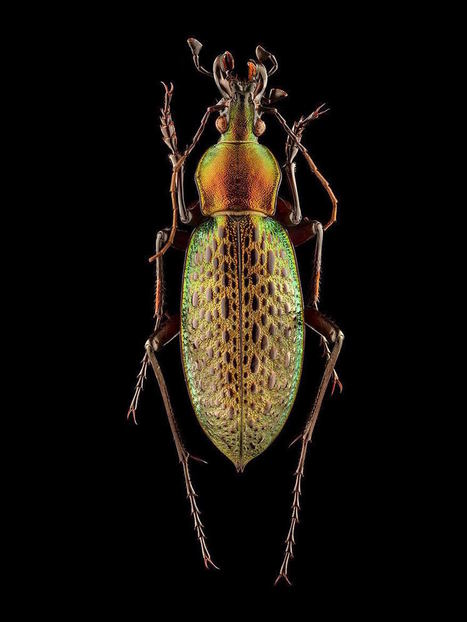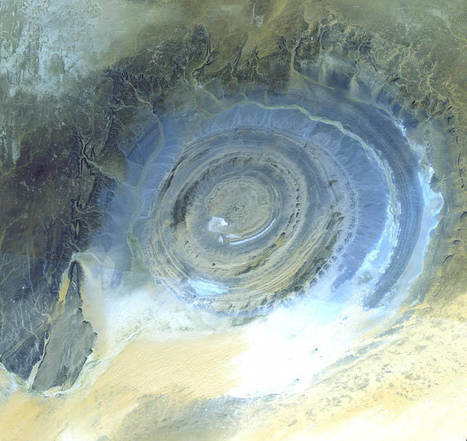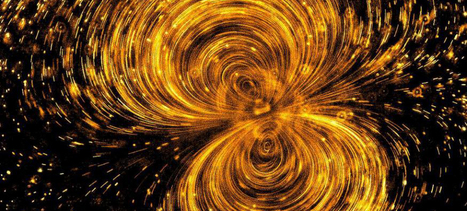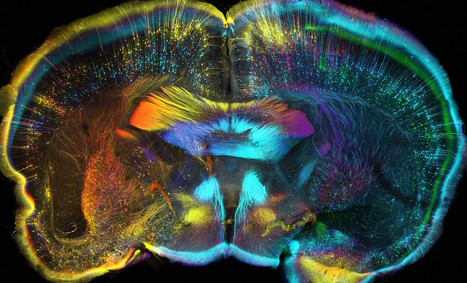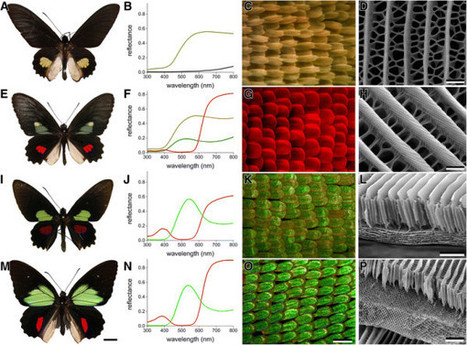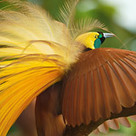 Your new post is loading...
Single-photon imaging is the future of high-speed digital photography and vastly surpasses conventional cameras in low-light conditions. However, fixing the blurring caused by the motion of independent objects remains challenging. Recently, researchers at Tokyo University of Science developed an innovative deblurring approach that accurately estimates the motion of individual objects and adjusts the final image accordingly. Their strategy produces high-quality images even in complex dynamic scenes and may find applications in medicine, science, and security. PDF file is here.
Commercial photographer Levon Biss typically shoots portraits of world-class athletes—sports players caught in motion. His new series however, catches subjects that have already been paused, insect specimens found at the Oxford Museum of Natural History. The series originally started as a side-project capturing the detail of bugs that his son would catch at home, and is now displayed at the museum in an exhibition titled Microsculpture. During the course of his selection from the museum’s collection Biss rejected more than 99% of the bugs he came across, only choosing those that were of the right size and color. To capture these subjects in such immense detail, each part of the insect required a completely different lighting setup. “I will photograph an antenna and light that antenna so it looks as best as it possibly can,” said Biss. “Once I move onto the next section, for example the eye, the lighting will change completely. I work my way across the whole body of the insect until I end up with 30 different sections, each photographed individually.” Working in this comprehensive manner required between 8,000 and 10,000 shots for each final image, moving the camera just ten microns (1/7th of the width of a human hair) between each shot. With this volume of imagery, it takes over two weeks for Biss to complete each photograph start to finish. You can see Microsculpture through October 30th at the Oxford University Museum of Natural History where the images are displayed next to their actual specimens. In case you can’t make it to the UK, you can take a detailed look at all 22 of Biss’s images on his interactive Microsculpture website. (via PetaPixel)
Did you ever imagine the sperm whales sleeping? How would that look like..? If you still can’t picture that, then let the Swiss photographer Franco Banfi help you out.
Recently Franco snapped an extremely rare shot of a group of sperm whales in their sleep. He and a team of scuba divers were following the pack in the Caribbean Sea, near Dominica Island, when suddenly the whales stopped moving and went into a synchronized vertical rest.
This behavior was first documented only back in 2008, when a team of biologists from the UK and Japan drifted into a group of stationary sperm whales. After studying tagged whales the team found out that this collective nap occurs for approximately 7 percent of the whale’s life, in short stretches of just 6-24 minutes.
This prominent circular feature in the Sahara desert of Mauritania has attracted attention since the earliest space missions because it forms a conspicuous bull's-eye in the otherwise rather featureless expanse of the desert. Described by some as looking like an outsized fossil in the desert, the structure has a diameter of almost 30 miles.
Peering into a grocery store bin, it's hard to tell if a peach or tomato or avocado is starting to go bad underneath its skin.
But an affordable camera technology being developed by the University of Washington and Microsoft Research might enable consumers of the future to tell which piece of fruit is perfectly ripe or what's rotting in the fridge.
The team of computer science and electrical engineers developed HyperCam, a lower-cost hyperspectral camera that uses both visible and invisible near-infrared light to "see" beneath surfaces and capture unseen details. This type of camera is typically used in industrial applications and can cost between several thousand to tens of thousands of dollars.
In a paper presented at the UbiComp 2015 conference, the team detailed a hardware solution that costs roughly $800, or potentially as little as $50 to add to a mobile phone camera. They also developed intelligent software that easily finds "hidden" differences between what the hyperspectral camera captures and what can be seen with the naked eye.
When HyperCam captured images of a person's hand, for instance, they revealed detailed vein and skin texture patterns that are unique to that individual. That can aid in everything from gesture recognition to biometrics to distinguishing between two different people playing the same video game.
As a preliminary investigation of HyperCam's utility as a biometric tool, in a test of 25 different users, the system was able differentiate between hand images of users with 99 percent accuracy.
In another test, the team also took hyperspectral images of 10 different fruits, from strawberries to mangoes to avocados, over the course of a week. The HyperCam images predicted the relative ripeness of the fruits with 94 percent accuracy, compared with only 62 percent for a typical camera.
"It's not there yet, but the way this hardware was built you can probably imagine putting it in a mobile phone," said Shwetak Patel, Washington Research Foundation Endowed Professor of Computer Science & Engineering and Electrical Engineering at the UW.
US scientists have developed an adhesive tape that can help objects match the infrared reflectance of their surroundings and disguise them from being seen by infrared cameras. The flexible coating – based on a protein found in cephalopod skin – can moderate reflectance simply by stretching and may find application in military camouflage kit.
Cephalopods – such as squid, octopuses and cuttlefish – are nature’s masters of disguise. Their skins contain iridophores, cells that reflect and manipulate incident light to spectacular effect. Their plasma membranes fold to encompass lamellar-like platelets containing reflectin. Reversible phosphorylation of reflectin changes the size and structure of the lamellae, changing the iridophore’s reflectance across the visible spectrum.
Alon Gorodetsky’s group at the University of California, Irvine, has developed a method for coating a thin-film of reflectin onto the surface of a flexible and transparent adhesive substrate layered with graphene oxide. These ‘stickers’, transparent under normal light, can be stuck onto any surface, including conventional camouflage with precise patterning. The reflectance can be controlled by stretching, and upon heating, the inexpensive material returns to its original state. ‘The protocols for making it are very scalable – putting a thin film on a standard roll of tape isn’t difficult and requires fairly little material so it shouldn’t be much more expensive than ordinary sticky tape one finds in their desk,’ Alon tells Chemistry World.
Besides stealth applications, Gorodetsky suggests that advanced versions of these materials might be used in glass coatings to regulate seasonal temperature. The team are keen to push the reflectance of reflectin-inspired materials as far as possible into the thermal infrared. ‘We hope to eventually develop autonomous clothing-integrated devices that will regulate how a person radiatively exchanges heat with their environment.’ The potential applications are exciting: ‘Wouldn’t it be neat if you had a jacket which could adapt to keep you cool on warm days and warm on cold days?’ adds Gorodetsky.
Jason Slinker, an optoelectronic materials expert at the University of Texas at Dallas, US, says the material should draw great interest from the apparel industry. ‘Such a stable, reversible, responsive, and inexpensive means of enhancing clothing with broad color changing capabilities will have applications in safety and camouflage as well as aesthetic implications in fashion.’
Without access to a microscope or a sophisticated zoom lens, most people don't get to see plant pores and cricket tongues up close. But the entrants in the 2014 Nikon Small World photography contest offer an intimate look at tiny realms rarely seen outside of a lab. The judges of the annual contest will reveal their top picks on Oct. 30, but the following images are a sample of the submissions. More information can be found on the contest website.
From slow-motion footage on YouTube to deep-space satellite imagery to weird washcloths on the International Space Station, this was a big year for science.
Mounted to the Mars Reconnaissance Orbiter as it floats high above the red planet is the HiRISE telescope, an imaging device capable of taking incredibly high-resolution photos of the martian landscape. It's sent back nearly 30,000 photos during its time above the planet, which have been used by NASA to find clear landing spots for rovers, and by researchers to learn more about the features of Mars' surface. The stunning views captured by HiRISE have inspired a book from the publisher Aperture, called This is Mars, which includes 150 of its finest looks at the planet. The entire collection is in black and white, however, as that's how HiRISE's images naturally turn out. But by combining different color filters on the telescope, NASA is able to produce colored versions of most images too. They're known as "false color" images, since they won't perfectly match up with what the human eye would see. False color images are still useful, however, in helping researchers distinguish between different elements of Mars' landscape. They're also downright gorgeous to look through. Below, we've collected our own series of some of the most incredible sights taken by HiRISE throughout 2013.
With 360 movie panels, the sky over an entire year is shown in time lapse format as recorded by a video camera on the roof of the Exploratorium museum in San Francisco, California. Each panel shows one day. The camera recorded an image every 10 seconds from before sunrise to after sunset and from mid-2009 to mid-2010. A time stamp showing the local time of day is provided on the lower right. The videos are arranged chronologically, with July 28 shown on the upper left, and January 1 located about about half way down. Although every day lasts 24 hours, daylight lasts longest in the northern hemisphere in June and the surrounding summer months, a fact which can be seen here as the bottom (and soon top) videos are the first to light up with dawn. The initial darkness in the middle depicts the delayed dawn and fewer daylight hours of winter. In the videos, darkness indicates night, blue depicts clear day, while gray portrays pervasive daytime cloud cover. Many videos show complex patterns of clouds moving across the camera's wide field as that day progresses. As the videos collectively end, sunset and then darkness descend first on the winter days just above the middle, and last on the mid-summer near the bottom.
With camera megapixel counts going through the roof, pixels have become incredibly small. Unfortunately, traditional sensor designs cover up the pixels with layers of wiring. If you were asked to design a camera sensor, you’d naturally put the photo receptors on top, closest to the light. Oddly enough, because of the way chips are fabricated, until recently most camera sensors have captured light at the bottom, underneath layers of interconnections. The recent introduction of back-illuminated (BI) sensor technology (also referred to as backside-illuminated or BSI) has changed all that. It is now possible to build sensors “the right way round” with the photo receptive layer facing the light. Back illumination has made some headlines for allowing better low-light performance, but its worth diving into the technology, as it is going to be a lot more important than that. Silicon is both the substrate on which chips are built and the material that performs the magic of turning photon energy into electrical energy that can be used to create images. It is therefore the simplest solution to create the photosensitive areas in the substrate silicon and stack the electronics on top — leaving openings in the wiring over each photosite (pixel) to allow light to pass through. As camera resolutions have increased, pixel sizes have decreased, especially in smartphones with their tiny sensors. The result is that more and more of the surface area of the sensor is covered by wiring, resulting in less and less light reaching the photosites. So there is a natural need to find a way to move the photosensitive region to the top of the chip, allowing it to gather more light. Curiously, the human eye and most animal eyes are also built with the photosensitive pigments on the side furthest away from the light streaming through the eyeball. It isn’t known exactly why eyes are designed that way, but designing them this way definitely makes it easier to provide circulation to the energy-hungry rods and cones, as well as allowing cellular debris to be whisked away without floating around inside the eyeball. Creatures like cephalopods who rely on their eyes in the dark waters of the deep ocean do indeed have their photoreceptors close to the lenses of their eyes, to maximize the sheer amount of light captured. If a sensor was only a layer of photosensitive silicon, it wouldn’t matter much which side was up. A pixel is a lot more than just the photodiode, however. It typically includes transistors and wiring for amplifying the charge, transferring it to the signal processing portion of the chip, and resetting itself between frames. Those electronics get placed on top of the silicon layer, partially obscuring it from the light and resulting in a well-like appearance for a typical pixel. As you’d expect, putting the photodiode at the bottom of a well reduces the amount of light that reaches it, with some light bouncing off the wiring above, and some just not having the right angle to make it to the bottom of the well. Microlenses are used to reduce this problem (the human eye uses waveguides known as Muller cells), but a meaningful amount of light is still lost before it gets to the photodiode to be captured. Typical sensor fill factors — the portion of light successfully captured — range from 30% to 80%. By contrast, a back-illuminated sensor can have a fill factor of nearly 100%.
Specialised Imaging Ltd., the leading technological innovator in ultra high-speed imaging, has introduced Kirana - a new ultra high-speed video camera that combines the flexibility of video technology with the resolution of an ultra high speed framing camera. Incorporating a proprietary hybrid camera sensor the compact Kirana Ultra High-Speed Video Camera is uniquely able to deliver high resolution (924 x 768 pixels) and high speed (up to 2 million frames / second) in a no compromise design. Using a Kirana High-Speed Video Camera up to 40 events can be captured at a cyclic rate of 250ms or 2 seconds of video stored when operating at 1,000 frames / second. The full resolution of this exciting new high-speed video camera is maintained at all speeds.
|
In a new international cross disciplinary study, researchers have used artificial intelligence to analyze large amounts of historical photos from WW2. Among other things, the study shows that artificial intelligence can recognize the identity of photographers based on the content of photos taken by them. Artificial Intelligence (AI) is finally able to identify photographers based on the content of images they've taken. This is the conclusion of a new study at AU Engineering, Aarhus University, where, in collaboration with Tampere University and the Finnish Environment Institute, researchers have used state-of-the-art artificial intelligence to trawl through photographs taken by 23 well-known Finnish photographers during the Second World War. The photographs used in the study are part of the publicly available Finnish Wartime Photograph Archive containing around 160,000 photographs from Finnish Winter, Continuation, and Lapland Wars captured in 1939-1945. The study was published in the scientific journal IEEE Access, and the researchers wanted to demonstrate the advantages of using modern neural networks to analyse images to such an extent that the machine could automatically detect people and objects in a variety of scenes and even distinguish photographers on the basis of characteristics in the image - all much faster than any manual reviewing process. Such an automatic analysis can serve as a tool for providing content-based textual descriptions of public photographic archives like the Photo Archives of the Museum of Danish Resistance, as it is now required at the European Union level. The EU Accessibility Directive (DIRECTIVE (EU) 2016/2102) came into effect in September 2020 and requires textual descriptions of image contents to be added to all public images on the Web.
Famous landmarks like the Arc Du Triumph, the Pyramids of Giza, and the Sagrada Familia have been photographed countless times by photographers from around the world.
An image of a gold chip that traps ions for use in quantum computing has come first in EPSRC's third science photography competition. ‘Microwave ion-trap chip for quantum computation’, by Diana Prado Lopes Aude Craik and Norbert Linke, from the University of Oxford, shows the chip’s gold wire-bonds connected to electrodes which transmit electric fields to trap single atomic ions a mere 100 microns above the device’s surface. The image, taken through a microscope in one of the university's cleanrooms, came first in the Eureka category as well as winning overall against many other stunning pictures, featuring research in action, in the EPSRC competition – now in its third year. Doctoral student Diana Prado Lopes Aude Craik, explained how the chip works: “When electric potentials are applied to the chip’s gold electrodes, single atomic ions can be trapped. These ions are used as quantum bits (‘qubits’), units which store and process information in a quantum computer. Two energy states of the ions act as the ‘0’ and ‘1’ states of these qubits. Slotted electrodes on the chip deliver microwave radiation to the ions, allowing us to manipulate the stored quantum information by exciting transitions between the ‘0’ and ‘1’ energy states. “This device was micro-fabricated using photolithography, a technique similar to photographic film development. Gold wire-bonds connect the electrodes to pads around the device through which signals can be applied. You can see the wire-bonding needle in the top-left corner of the image. The Oxford team recently achieved the world’s highest-performing qubits and quantum logic operations.” The development of the ion-trap chip was funded jointly by the EPSRC and the US Army Research Office. The competition’s five categories were: Eureka, Equipment, People, Innovation, and Weird and Wonderful. Winning images feature: - A spectacular 9.5 meter wave created to wow crowds at the FloWave Ocean Energy Research Facility at the University of Edinburgh
- An iCub humanoid robot learning about how to play from a baby as part of robotics research taking place at Aberystwyth University
- The intense, blinding light of plasma formed by an ultrafast laser being used to process glass at the EPSRC Centre for Innovative Manufacturing in Ultra Precision at the University of Cambridge
- A beautiful rotating jet of viscoelastic liquid water resembling a spinning dancer that demonstrates the effect of adding a tiny amount of polymer to water and an example of fluid dynamics research at Imperial College London
One of the judges was Professor Robert Winston, he said: “This competition helps us engage with academics and these stunning images are a great way to connect the general public with research they fund, and inspire everyone to take an interest in science and engineering.”
Most wouldn't go looking for magnified cat tongues, sheep stomachs, or parasitoid wasps in a search for gorgeous imagery. But as the finalists for the 2015 Wellcome Image Awards show, these things can be breathtakingly beautiful.
The award showcases the best in science images for the year. "The breath-taking riches of the imagery that science generates are so important in telling stories about research and helping us to understand often abstract concepts," British geneticist, author, and broadcaster Adam Rutherford, one of this year's judges, said in a statement.
"It's not just about imaging the very small either, it's about understanding life, death, sex and disease: the cornerstones of drama and art. Once again, the Wellcome Image Awards celebrate all of this and more with this year’s incredible range of winning images," Rutherford said.
The images are part of the Wellcome Images collections, which are free for non-commercial use and intended to help illustrate scientific concepts and findings.
The winner will be announced at an awards ceremony on March 18. To see previous year's winners, check out Wellcome's Web site. The 20 finalists for 2015 will be showcased at 11 science centers around Britain. Fans of beauty and science in the United States are in luck, too: MIT's Koch Institute and The University of Texas Medical Branch at Galveston will also show off the winners sometime in March.
For centuries, people have reported seeing luminous, spherical orbs during storms — a phenomenon known as “ball lightning”.
According to eyewitness reports they last for several seconds, moving through the air before eventually exploding. But meteorologists have always regarded such reports with suspicion, as they’d never been able to observe the phenomenon themselves. Inconsistencies in public reports led those studying these cases starting to think of them like UFO sightings — merely hallucinations, perhaps caused by electromagnetic effects. Now, however, following years of attempts to replicate ball lightning in the lab, Chinese researchers have finally recorded it in the field.
Jianyong Cen, Ping Yuan, and Simin Xue were using spectrographs and video cameras to observe a thunderstorm near Qinghai in China’s desolate western provinces when they saw something they weren’t expecting. After a bolt of lightning hit the ground, a glowing ball about five metres wide rose up and travelled about 15 metres, before disappearing about 1.6 seconds later. Stunned, the researchers packed up their kit and headed back to their lab, where they discovered that the elements in the ball were the same as those in the local soil — silicon, iron and calcium. They published their results in the journal Physical Review Letters.
Their results lend credence to a theory first laid out in 1999 by John Abrahamson, a chemist at the University of Canterbury in New Zealand. His theory goes that when lightning strikes the ground, it immediately stores energy in silicon nanoparticles in the soil. The force of the strike then ejects those particles into the air, where they’re oxidised and release that energy as heat and light, glowing briefly.
That doesn’t explain away all the situations where ball lightning has been seen — like on aircraft flying high in the sky. But Abrahamson says that his findings fit the Chinese researchers’ results nicely. “Here’s an observation which has all the hallmarks of our theory,” he told New Scientist. “This is gold dust as far as confirmation goes.”
Photography (derived from the Greek word "photos" for "light" and "graphos" for "drawing") is the art, science, and practice of creating durable images by recording light or other electromagnetic radiation, either chemically by means of a light-sensitive material such as photographic film, or electronically by means of an image sensor. Typically, a lens is used to focus the light reflected or emitted from objects into a real image on the light-sensitive surface inside a camera during a timed exposure. Photography has many uses for business, science, manufacturing, art, recreational purposes, and mass communication.
Exclusive timelapse: See climate change, deforestation and urban sprawl unfold as Earth evolves over 30 years. Spacecraft and telescopes are not built by people interested in what’s going on at home. Rockets fly in one direction: up. Telescopes point in one direction: out. Of all the cosmic bodies studied in the long history of astronomy and space travel, the one that got the least attention was the one that ought to matter most to us—Earth. That changed when NASA created the Landsat program, a series of satellites that would perpetually orbit our planet, looking not out but down. Surveillance spacecraft had done that before, of course, but they paid attention only to military or tactical sites. Landsat was a notable exception, built not for spycraft but for public monitoring of how the human species was altering the surface of the planet. Two generations, eight satellites and millions of pictures later, the space agency, along with the U.S. Geological Survey (USGS), has accumulated a stunning catalog of images that, when riffled through and stitched together, create a high-definition slide show of our rapidly changing Earth. TIME is proud to host the public unveiling of these images from orbit, which for the first time date all the way back to 1984. Over here is Dubai, growing from sparse desert metropolis to modern, sprawling megalopolis. Over there are the central-pivot irrigation systems turning the sands of Saudi Arabia into an agricultural breadbasket — a surreal green-on-brown polka-dot pattern in the desert. Elsewhere is the bad news: the high-speed retreat of Mendenhall Glacier in Alaska; the West Virginia Mountains decapitated by the mining industry; the denuded forests of the Amazon, cut to stubble by loggers. It took the folks at Google to upgrade these choppy visual sequences from crude flip-book quality to true video footage. With the help of massive amounts of computer muscle, they have scrubbed away cloud cover, filled in missing pixels, digitally stitched puzzle-piece pictures together, until the growing, thriving, sometimes dying planet is revealed in all its dynamic churn. The images are striking not just because of their vast sweep of geography and time but also because of their staggering detail. Consider: a standard TV image uses about one-third of a million pixels per frame, while a high-definition image uses 2 million. The Landsat images, by contrast, weigh in at 1.8 trillion pixels per frame, the equivalent of 900,000 high-def TVs assembled into a single mosaic. These Timelapse pictures tell the pretty and not-so-pretty story of a finite planet and how its residents are treating it — razing even as we build, destroying even as we preserve. It takes a certain amount of courage to look at the videos, but once you start, it’s impossible to look away.
The Lytro camera is likely one of the cooler pieces of tech to be developed so far this century. What makes this camera so great is its ability to capture the entire light field in a given scene. This data is then stored in the digital image, making it possible to focus on all parts of the picture after it’s been taken. Photos taken with the Lytro camera are interactive in a sense, allowing the viewer to look at every part of the image in a clearer view rather than be stuck at one static point of view. Though the Lytro is responsible for some very cool photos, the technology still has a way to go. As it stands, the camera is a bit pricey (about $400) and requires plenty of light and a steady hand to take the right picture. Additionally, in order to make full use of the camera’s potential, it’s easier for trained photographers to get just the right shot. For better or worse, Toshiba has said they’ll be bringing this kind of technology to smartphones in the next 2 years. According to MobileBurn.com, Toshiba has created a tiny lytro-esque sensor which can fit in today’s mobile devices, such as smartphones and tablets. This new camera module works by placing half a million tiny lenses in front of the sensor in order to capture light from all angles. These lenses work to provide the sensor with an exorbitant amount of data, such as the angles of light and other elements of the scene in question, This data is then compiled into one image which the end user can then edit and shift the focus, should they want to.
It took eight years. But now every bird of paradise species has been photographed in the wild.
Birds of paradise represent an extreme example of Charles Darwin’s theory of sexual selection: Females choose mates based on certain appealing characteristics, thus increasing the odds that those traits will pass from one generation to the next. In New Guinea an abundance of food and a scarcity of predators have allowed the birds to flourish—and to exaggerate their most attractive traits to a degree that even literal-minded scientists have called absurd.
The brilliant plumes have been prized as decorative objects in Asia for thousands of years. Hunters who traded the first specimens to Europeans in the 16th century often removed the birds’ wings and legs to emphasize plumes. This inspired a notion that they were literally the birds of the gods, floating through the heavens without ever alighting, gathering sustenance from the paradisiacal mists.
|



 Your new post is loading...
Your new post is loading...



